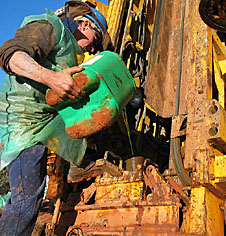 Hydraulic fracturing fluids commonly consist of water, ‘proppants’ and chemical additives that open, enlarge and maintain fractures within the rock formation. The proppants – sand, ceramic pellets or other small incompressible particles – hold the newly created fracture open. The fracture widths are generally equal to a few diameters of the grains used in the frac (typically less than 1 mm).
Hydraulic fracturing fluids commonly consist of water, ‘proppants’ and chemical additives that open, enlarge and maintain fractures within the rock formation. The proppants – sand, ceramic pellets or other small incompressible particles – hold the newly created fracture open. The fracture widths are generally equal to a few diameters of the grains used in the frac (typically less than 1 mm).
The fluids most commonly used for fracturing are water based. Various chemicals are also added at selected stages of the fracturing operation. During multistage fracturing a series of different volumes of fracturing fluids is injected with specific concentrations of proppant and other additives allowing each stage to address local conditions, such as the presence of natural faults, and proximity to other wells.
Most of the fluid is composed of water (about 98 to 99% of total volume); commonly fresh water is used with a total dissolved solids concentration of less than 500 mg/L. The proppant and chemicals usually comprise about 1 to 2% of the total volume. Chemical additives may include some or all of:
- Scale Inhibitors, to prevent scale build up on the walls of the well and eliminate the potential for blockage of tubing and equipment;
- Acid, may be used in some cases to reduce fracture initiation pressure and to clean up excess cement;
- Iron Reducing Agents, materials such as stannous chloride are capable of reducing ferric iron containing compounds to ferrous iron containing compounds in an acidic solution, such as one used for formation acidizing;
- Disinfectants or Biocides, used to control the growth of certain kinds of microbes that would destroy gelled fracture fluids, or to kill bacteria that can produce hydrogen sulphide and lead to corrosion;
- Friction Reducers, reduce the friction of the fluid flowing through the pipe during high rates of pumping;
- Surfactants, reduce the viscosity of the fracturing fluid, modify surface or interfacial tension, and break or prevent emulsions;
- Gelation Chemicals, act as thickeners to initiate the fractures and carry some of the sand; and
- Corrosion Inhibitors, absorbed onto steel and then in the formation to prevent corrosion.
In some countries the chemicals used in fracturing fluid are considered trade secrets – but others require disclosure. In Canada regulators are actively moving to full disclosure geological characteristics of the formation.8 The higher volume also creates more flow back water which requires treatment. Freshwater was necessary early in the development of certain US sites when friction reducers, scale inhibitors and surfactants showed performance difficulties when mixed with saline waters. Alternative frac fluid chemistries have been developed during the past few years allowing the use of saline (salt) water, recycling of frac fluid from previous operations and municipal waste water from sewage treatment plants to be used instead of fresh water. In fact the Horn River production reservoir in northeastern British Columbia is considered world leading in utilizing saline water from subsurface aquifers to support large-scale frac operations.
If you have questions or would like information on any of our products, please contact us.
